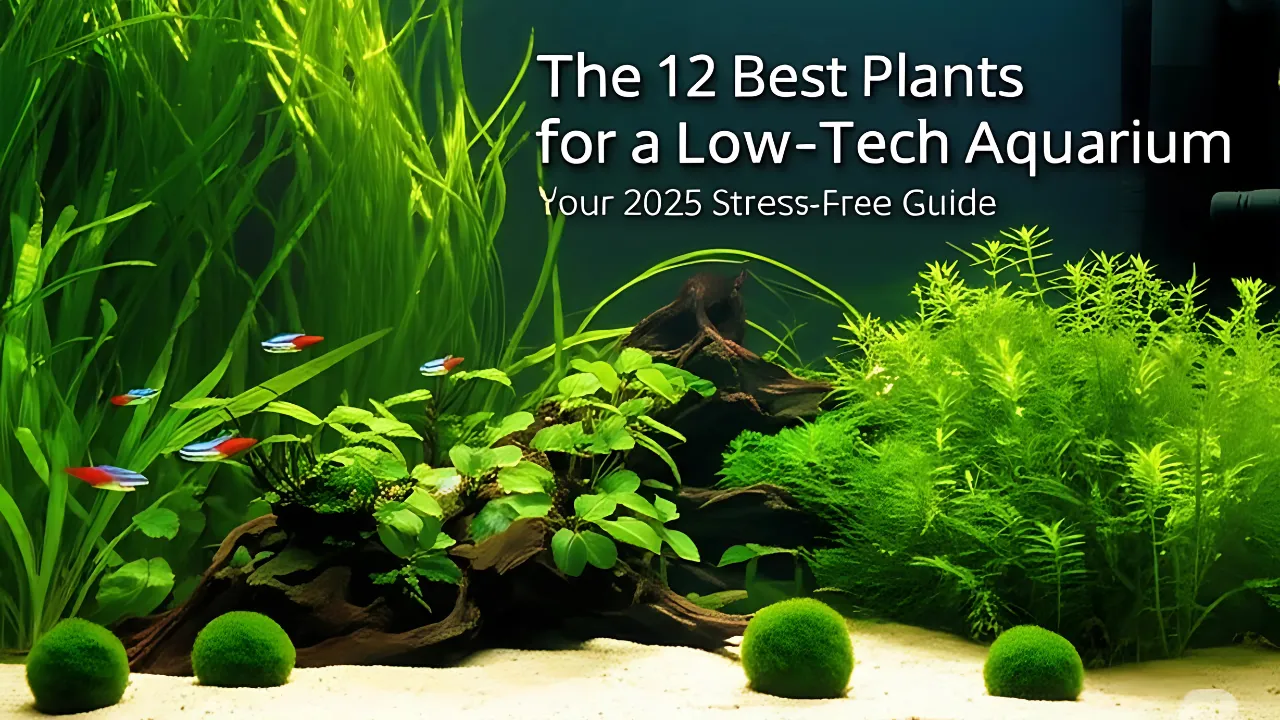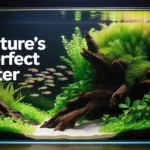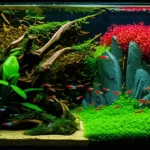So, you’re dreaming of a lush, vibrant underwater world, filled with graceful green leaves swaying in the current. But then you start looking online and see complicated CO2 systems, blindingly bright lights, and talk of complex chemical fertilizers. It can feel a bit overwhelming, can’t it?
Well, take a deep breath and relax. You have found the right place. Here at AquaInitium, we believe that creating a stunning planted aquarium shouldn’t give you a headache or empty your wallet. You absolutely can have that beautiful, thriving aquascape without all the high-tech fuss.
The secret is choosing the right plants! This guide isn’t just another boring list. We’ve structured it exactly how you’d think about designing your tank: from the tall plants in the back to the short plants in the front. We’ll cover the best, hardiest, and most beautiful plants that thrive in simple, low-tech setups. Let’s get started on picking the green team for your stress-free aquarium!
The Foundation: Background Plants
Background plants are the tall, leafy heroes that create the backdrop for your entire aquascape. They hide equipment like filters and heaters, add a wonderful sense of depth, and make your tank feel like a lush, complete world.
1. Hornwort (Ceratophyllum demersum)
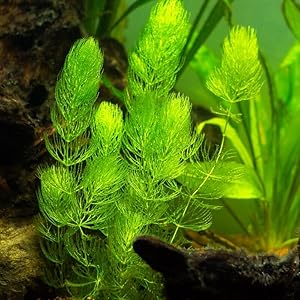
Hornwort: At-a-Glance
- Placement: Floating or loosely anchored in the background
- Lighting: Very Low to High
- Growth Rate: Very Fast
- Key to Success: Just let it do its thing! It’s incredibly undemanding.
My Advice: Hornwort is an absolute superstar for beginner low-tech tanks. Honestly, it’s harder to kill this plant than it is to grow it! I’ve used it as a “starter plant” in almost every new tank to help stabilize the ecosystem. It grows incredibly fast, which is fantastic because it soaks up excess nutrients from the water like a sponge.
This directly helps to prevent algae from taking over, which is a common worry for new hobbyists. Its texture is unique—a bit brittle and almost bristly, like a soft bottle brush—which adds a beautiful, fine-leafed look to the back of any aquarium.
From Store to Substrate: When you get Hornwort, it will likely be a loose bunch of stems. You have two easy options: you can simply let it float freely at the top of your tank, or you can gently tuck the bottom ends into your gravel or substrate. Don’t worry about planting it perfectly; it doesn’t grow traditional roots and will absorb what it needs directly from the water. Just be aware that it can shed its “needles” if conditions change suddenly, but don’t panic – it almost always bounces back.
2. Water Wisteria (Hygrophila difformis)

Water Wisteria: At-a-Glance
- Placement: Background
- Lighting: Low to Medium
- Growth Rate: Fast
- Key to Success: Give it a little room to spread out.
My Experience: Water Wisteria is one of my all-time favorite plants for beginners. I’ve used it in countless tanks, and it never disappoints. It’s beautiful, grows quickly, and its unique, lacy-looking leaves are a fantastic indicator of your tank’s health.
When it’s happy, it will grow tall and lush, creating an amazing green wall at the back of your tank. Like Hornwort, its fast growth makes it great for using up nutrients that could otherwise feed algae. It’s a forgiving and rewarding plant that makes you feel like an aquascaping pro right from the start.
From Store to Substrate: Water Wisteria usually comes in a bunch. You’ll want to separate it into individual stems. Using tweezers, plant each stem into your substrate, making sure they are about an inch or two apart to give them room to grow. A cool trick with this plant is that if you ever trim the top off, you can simply replant the cutting right back into the substrate, and it will grow into a whole new plant!
3. Vallisneria (Vallisneria species)

Vallisneria: At-a-Glance
- Placement: Background
- Lighting: Low to Medium
- Growth Rate: Medium to Fast
- Key to Success: Plant the crown (where the leaves meet the roots) just above the substrate.
My Advice: Often called “Val,” this plant is perfect for creating a background of thin, ribbon-like leaves that sway together in the current. It sends out runners and spreads on its own, eventually creating a dense and beautiful green curtain.
There are many types, like Jungle Val or the twisting Corkscrew Val. It’s incredibly hardy and a classic choice for low-tech tanks for a very good reason: it just works.
From Store to Substrate: Val usually comes as a single plant with roots. The most important tip is not to bury it too deep. Find the “crown” – the white part where the green leaves start and the roots begin. You want to plant it so the crown is sitting right on top of your gravel or sand, with only the roots buried beneath. If you bury the crown, the plant will likely rot. Give it time, and you’ll soon see new baby plants popping up nearby!
The Stars of the Show: Midground & Hardscape Plants
These are your character plants! They have interesting shapes and textures and are perfect for placing in the middle of your tank or, even better, attaching directly to rocks and driftwood to create amazing focal points.
4. Anubias Nana (Anubias barteri var. nana)

Anubias Barteri: At-a-Glance
- Placement: Attached to Hardscape (Wood/Rock)
- Lighting: Very Low to Medium
- Growth Rate: Very Slow
- Key to Success: Never, ever bury the rhizome (the thick horizontal stem).
My Experience: Anubias is the undisputed king of indestructible aquarium plants. It’s tough as nails and its thick, leathery leaves are so waxy they almost repel water. It can handle almost any water conditions you throw at it.
Because it’s a slow grower and feeds from the water, you don’t even need a fancy substrate. It’s the perfect plant to glue or tie to a piece of driftwood to instantly make your tank look more established and natural.
From Store to Substrate: When you buy Anubias, it often comes in a plastic pot with a dense material like rock wool around the roots. You must gently remove all of that wool. If you bury the rhizome – the thick, green, horizontal stem that the leaves and roots grow from – it will rot and the entire plant will die.
Why does this happen? The rhizome isn’t a root; it’s a thick, energy-storing stem that needs to be exposed to the water column to ‘breathe.’ Burying it is like suffocating the plant’s life support system. Instead, use a dab of aquarium-safe super glue gel or a piece of cotton thread to attach it to a rock or piece of wood. The roots will eventually grab on themselves.
5. Java Fern (Microsorum pteropus)

Java Fern: At-a-Glance
- Placement: Attached to Hardscape (Wood/Rock)
- Lighting: Low to Medium
- Growth Rate: Slow
- Key to Success: Just like Anubias, do not bury the rhizome!
My Advice: Right alongside Anubias, Java Fern is another must-have for any low-tech beginner. It’s incredibly hardy and has a unique, textured leaf shape that provides a fantastic contrast to other plants. It comes in a few cool varieties too, like ‘Narrow Leaf’ and the frilly ‘Windeløv’ (Lace Java Fern). It requires very little light and will happily grow attached to your hardscape, making it super versatile for design.
From Store to Substrate: The rule for Java Fern is the same as for Anubias. It grows from a rhizome, so it must not be buried. Attach it to rocks or wood with super glue gel or thread. Don’t be alarmed if you see little brown or black dots on the undersides of the leaves; these are spores, which is how the fern reproduces. You might even see tiny new baby plants growing right off the tips of the older leaves! You can pluck these off when they have a few roots and attach them elsewhere in your tank.
6. Bucephalandra (‘Buce’)

Bucephalandra: At-a-Glance
- Placement: Attached to Hardscape (Wood/Rock)
- Lighting: Low to Medium
- Growth Rate: Very Slow
- Key to Success: Provide stable water conditions and don’t bury the rhizome.
My Experience: Bucephalandra, or “Buce” for short, has become incredibly popular, and for good reason! Think of it as a more exotic, jewel-like cousin to Anubias. They are rhizome plants that come in hundreds of varieties with different leaf shapes and amazing colors, often with a subtle, glittery sheen.
While some can be rare and expensive, common and hardy varieties like ‘Green Wavy’ or ‘Kedagang’ are perfect for low-tech beginners who want to add a touch of something special to their hardscape. For more info on different types, check out resources from dedicated plant suppliers [Link to a reputable online aquatic plant store's Bucephalandra section].
From Store to Substrate: Just like Anubias and Java Fern, Buce is a rhizome plant. Gently glue or tie it to your hardscape. The key to success with Buce is stability. It doesn’t like big, sudden changes in water parameters. When you first add it to your tank, it might “melt” a bit (lose some leaves), which is normal as it adjusts. Be patient, keep your water conditions stable, and it will bounce back with new, beautiful growth.
Common Question: My Buce’s leaves are disappearing! Is it dead? Quick Answer: Probably not! Buce is known to “melt” when moved to a new environment. As long as the rhizome (the stem) is firm and not mushy, it’s just adapting. don’t move it. Just give it a few weeks, and you should see tiny new leaves starting to sprout.
The Ground Cover: Foreground & Carpeting Plants
These are your short plants that live at the front of the tank. They create the “lawn” or ground cover of your aquascape, giving it a finished, professional look.
7. Staurogyne Repens (S. Repens)

Staurogyne Repens: At-a-Glance
- Placement: Foreground
- Lighting: Low to Medium
- Growth Rate: Slow to Medium
- Key to Success: Plant individual stems deep into the substrate.
My Advice: Finding a good carpeting plant for a low-tech tank can be tricky, but S. Repens is a fantastic option. It’s not a “true” tiny-leaf carpet like some others, but it stays short and will spread out to form a dense, bright green bush or foreground carpet.
It’s much less demanding than many other carpeting plants and provides a vibrant splash of color at the front of your tank. It’s a great choice to bridge the gap between midground plants and the very front of the glass.
From Store to Substrate: S. Repens usually comes in a pot. You’ll want to separate the plant into many individual stems. This feels tedious, but it’s worth it! Using tweezers, plant each stem individually into your substrate, about half an inch apart. This encourages the plant to spread sideways and form a carpet, rather than just growing straight up. Regular trimming will also help keep it low and dense.
8. Marimo Moss Ball (Aegagropila linnaei)
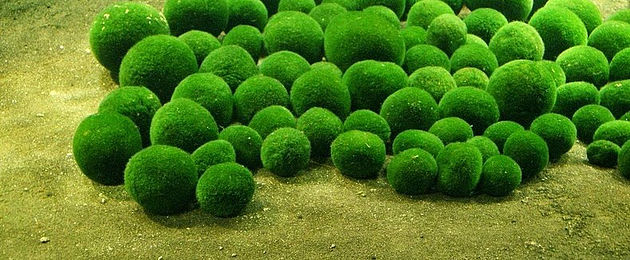
Marimo Moss Ball: At-a-Glance
- Placement: Foreground
- Lighting: Very Low to Medium
- Growth Rate: Incredibly Slow
- Key to Success: Roll it around occasionally to keep its shape.
My Advice: Okay, so technically a Marimo Moss Ball isn’t a plant—it’s a rare form of algae that grows into a neat little sphere. But it’s one of the most charming and easiest things you can add to an aquarium!
They require almost zero care and add a quirky, interesting touch to the foreground. They look great in groups of different sizes and are completely beginner-proof. Kids love them, shrimp love grazing on them, and they are a fun, no-fuss addition.
From Store to Substrate: When you get your Marimo, give it a gentle rinse and squeeze in some aquarium water (like wringing out a sponge). Then, just plop it into your tank! That’s it. Once every week or two during your water change, you can take it out and gently roll it in your palms to help it keep its round shape. If it ever gets brown spots, just move it to a spot with a little less light.
9. Cryptocoryne Parva
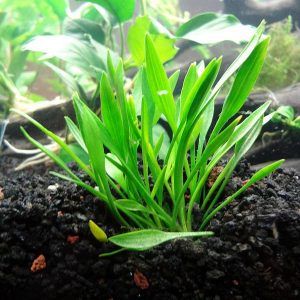
Cryptocoryne Parva: At-a-Glance
- Placement: Foreground
- Lighting: Low to Medium
- Growth Rate: Very Slow
- Key to Success: Be patient! It’s a slow starter but very stable once established.
My Experience: Cryptocoryne parva is one of the smallest species of Crypts, making it a true foreground plant. It forms little grass-like tufts and is incredibly hardy in a stable, low-tech tank.
This isn’t a plant for the impatient, as it can take many months to really fill in. But its slow growth is a benefit—it means you’ll almost never have to trim it! It’s perfect for creating a low, textured “lawn” effect at the front of your scape without any fuss once it gets settled.
From Store to Substrate: Like other Crypts, parva may come in a pot with rock wool. Carefully remove the wool and separate the plant into small clumps or individual plantlets. Using tweezers, plant these clumps into your substrate. Crypts are root feeders, so they will really appreciate a nutrient-rich substrate or having a root tab placed near them.
Be warned: it is famous for the ‘Crypt melt’ when first planted. Don’t be surprised if the leaves die back. The old leaves were likely grown emersed (out of water) at the farm and aren’t suited for underwater life. The plant sheds them to grow new leaves that are specifically adapted for your tank’s unique water chemistry. As long as the root structure is healthy, it will grow back. Just be patient!
Common Question: It’s been a month and my Crypts haven’t grown at all. Are they dead? Quick Answer: Almost certainly not! Crypts are famous for being slow starters. As long as the base isn’t mushy, just give it time. It’s spending its energy building a strong root system before putting out new leaves. Patience is the key.
The Problem Solvers: Floating Plants
Floating plants are secret weapons for a healthy low-tech tank. They float on the water’s surface, growing incredibly fast by pulling nutrients directly from the water. This helps to outcompete algae, and their dangling roots and shaded areas provide a natural, secure feeling for fish.
10. Amazon Frogbit (Limnobium laevigatum)
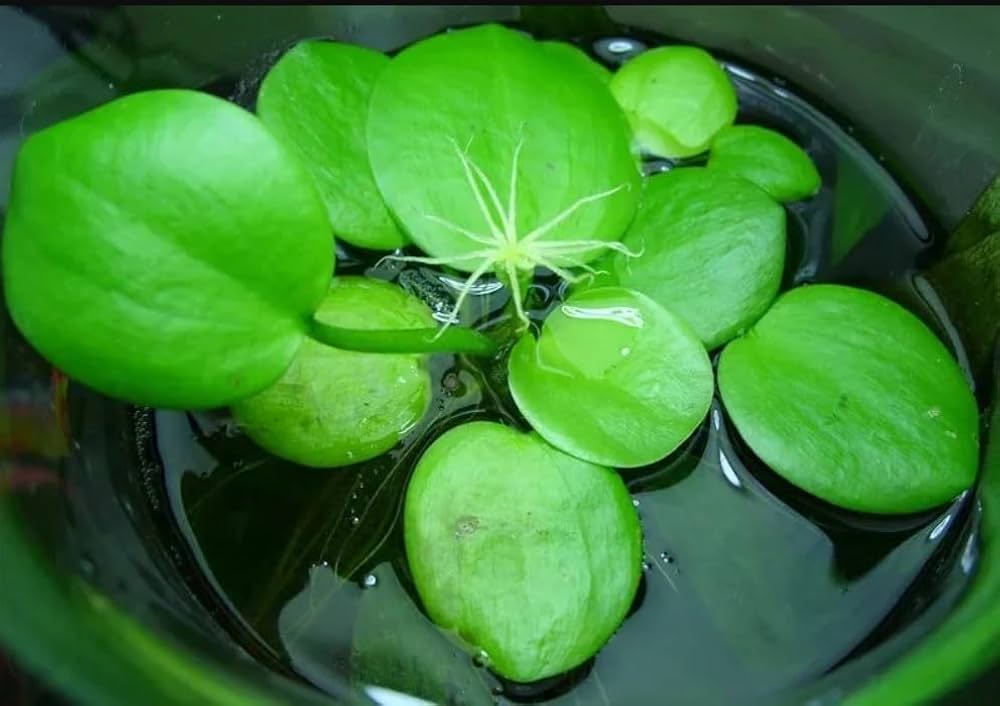
Amazon Frogbit: At-a-Glance
- Placement: Floating (Surface)
- Lighting: Any
- Growth Rate: Very Fast
- Key to Success: Keep the tops of the leaves dry.
My Advice: Frogbit is a fantastic floating plant. It has round, lily-pad-like leaves and long, beautiful, feathery roots that dangle down into the water, which looks amazing. It multiplies very quickly, forming a nice canopy on the surface.
This canopy can help dim overly bright lights, which can be a great way to control algae and make more timid fish feel safe. Because it grows so fast, it’s a nitrate-sucking machine!
From Store to Substrate: There’s no planting involved here! You just float it on the water’s surface. The main tip for Frogbit is to make sure your filter outflow doesn’t constantly splash water on top of the leaves, as this can cause them to rot. You can use a piece of airline tubing to create a floating ring to keep an area clear for feeding or to contain the Frogbit if it starts to take over. To maintain it, simply scoop out excess plants as needed.
11. Salvinia Minima
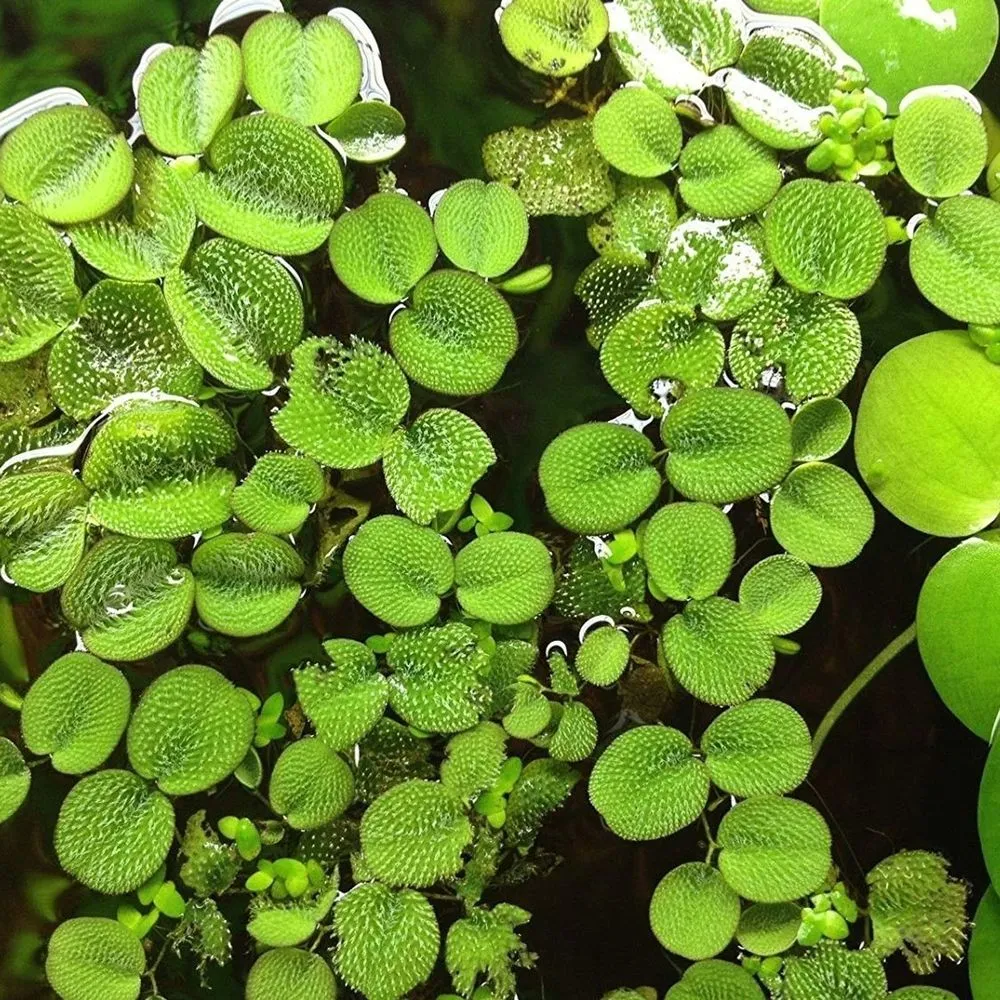
Salvinia Minima: At-a-Glance
- Placement: Floating (Surface)
- Lighting: Any
- Growth Rate: Very Fast
- Key to Success: Just add it to the water and watch it grow!
My Advice: If you want a smaller, more delicate floating plant, Salvinia is a wonderful choice. It has small, fuzzy, oval-shaped leaves that grow in chains and quickly form a dense mat on the surface.
Its roots are much shorter than Frogbit’s, giving a different look. It’s incredibly effective at nutrient removal and providing shade. It’s also very easy to manage; you just scoop out handfuls when it gets too thick.
From Store to Substrate: Just like Frogbit, you simply place Salvinia on the water’s surface and let it do its thing. It is very hardy and doesn’t require any special care. It can multiply extremely fast, so be prepared to remove some regularly to ensure enough light still gets through to the plants below.
12. Red Root Floaters (Phyllanthus fluitans)
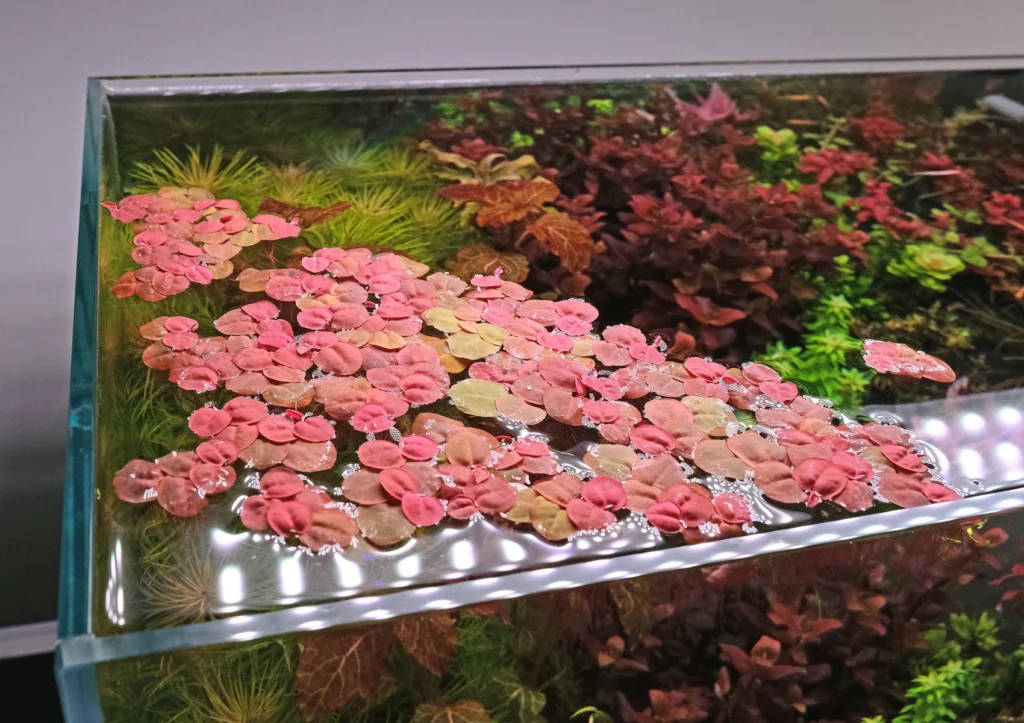
Red Root Floaters: At-a-Glance
- Placement: Floating (Surface)
- Lighting: Medium to High (for best color)
- Growth Rate: Medium to Fast
- Key to Success: Lower water flow at the surface helps them thrive.
My Experience: For those wanting a pop of color, Red Root Floaters are the answer. While the leaves are typically green, under good lighting conditions and with the right nutrients, their roots will turn a spectacular, deep red. The leaves themselves can also develop red edges. They provide the same great benefits as other floaters—nutrient absorption and shade—but with an added splash of unique color that can really make your tank stand out.
From Store to Substrate: Float them on the surface just like the others. To get the best red coloration in their roots, they do appreciate slightly more intense lighting than some other floaters, and they prefer calmer water at the surface. If your filter output creates a lot of surface agitation, they might get pushed around or submerged, which they don’t like. Using a floating ring to corral them can be very effective.
Your First Low-Tech Plant Trio
Feeling a little overwhelmed by all the choices? Don’t worry, that’s completely normal! To make it super simple, here is a can’t-fail plant combination for a beginner’s 10-gallon tank that provides height, texture, and interest. This trio is beautiful, balanced, and almost impossible to kill.
- Background: Water Wisteria (Hygrophila difformis) (1 bunch)
- Midground: One Anubias Nana (Anubias barteri var. nana) (to attach to a small rock or piece of wood)
- Foreground: Three Marimo Moss Balls (Aegagropila linnaei)
This combination will give you a fantastic start. As you build your confidence and learn more about your tank’s specific conditions, you can easily add more interesting plants from the list above to fill out your aquascape.
The Journey Begins…
Now that you’ve chosen your team of plants, the final step is to build their home. Our Ultimate Guide to Low-Tech Aquascaping will walk you through everything else—choosing the right light, substrate, and setting up the tank—to bring your underwater world to life!
We’re so excited for you to start. This hobby is all about learning, creating, and enjoying the process.
About the Author
Daniel Rivera is the founder of AquaInitium and has been keeping and enjoying low-tech planted aquariums for over 8 years. He believes that the most beautiful aquascapes are often the simplest and is dedicated to helping new hobbyists succeed without the stress of complicated equipment.
What’s the one plant you’d recommend to any low-tech beginner? Let me know in the comments below!
